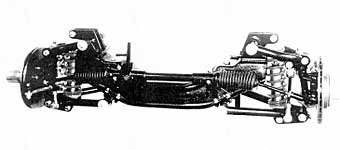
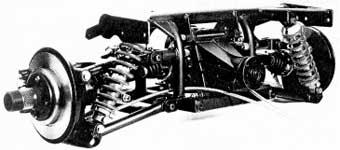
Hoyle Suspension Upgrades for the MGB
as published in British V8 Newsletter, Volume XIII Issue 1, January 2005by: Larry Shimp
The suspension comes in several forms with several options. Simplest is the front, where the only option is polyurethane or MGB V8 rubber bushings (or no bushings at all, owner supplied). I choose to have the MGB V8 rubber bushings factory installed. The rear suspension comes almost anyway you want. It can be a complete, assembled unit, or just the just the fabricated components. In England and Europe the ready availability of Ford Scorpio/Sierra parts makes the incomplete form a viable option. Here, parts are so hard to find, I went with the full assembly. If you do buy just the kit, at least get the optional shortened and rebuilt half-shafts, and the custom hubs and brake rotors, then everything else is stock Scorpio stuff. I choose the 3.38 ratio Scorpio V6 limited slip differential. Other differentials and ratios are available, but be wary of the 4 cylinder differentials because they are too weak for a V8. The strongest differential is the Cosworth unit, but its ratio is too low (about 4:1). However, the V6 differentials are strong enough for most applications. They are used successfully in Scorpio/Sierra, Ford and Rover V8 conversions in Britain and Australia, and these cars are significantly heavier than MGB's. Hoyle sells used, rebuilt differentials. They come painted in a silver aluminum color and not the natural factory finish. If you care, I suppose the paint can be removed and the underlying metal cleaned up.
I bought the Hoyle suspension, both front and rear, before there were any US distributors
(and the dollar-pound exchange rate was lower). I understand that the front suspension,
but not the rear, is now available in the US. When I ordered the suspension I had three
delivery options: by sea delivered to my house; by air delivered to my house, and by air,
where I arrange customs clearing myself. The latter was the least expensive option and
the one I chose. After the shipment arrived at Kennedy airport (outside of New York) I
spent a day dealing with the customs bureaucracy. The suspenseful part was awaiting the
decision on the import duty: if the inspector believed the parts were for my own use,
the fee was a nominal $20, if he believed the parts were for resale, then the duty was
a substantial percentage of the purchase price. Luckily I only had to pay the nominal
fee. To get the parts home (nicely packed in two crates) I had to borrow a friend's
pick-up truck. Unloading at home required an engine hoist.
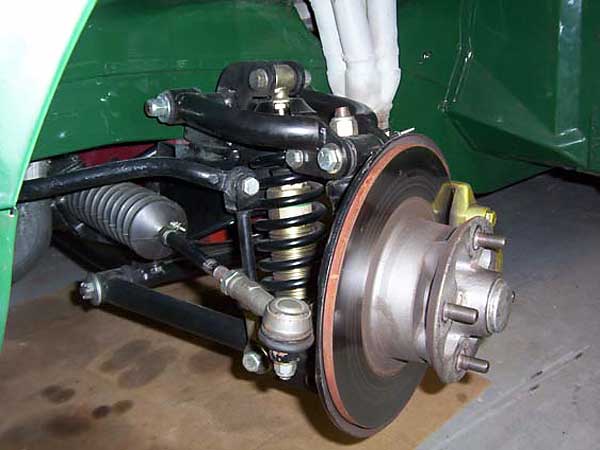

Front Suspension
The kit uses the stock cross member (with modifications), the spindle assemblies and the lower A-arm pivots. All the rest of the parts are custom, and like the rear, are mainly powder coated steel tubing. Unlike the rear suspension, some fabrication is required to assemble the front suspension. To clear the shock/spring assemblies, the ends of MGB cross member must be cut off and the supplied curved plates welded in. This is very easy because the metal is so thick. Just turn the welder current up and have at it. There is no chance of burning holes as with body sheet metal.Be sure that the curved plates are set far enough back to clear the springs on full compression. As the springs are compressed, they move inward. Without driving the car, it is impossible to compress the springs fully to check this, so if in doubt, be generous with the clearance.
|
Enjoying this article? Our magazine is funded through the generous support of readers like you! To contribute to our operating budget, please click here and follow the instructions. (Suggested contribution is twenty bucks per year. Feel free to give more!) |
Assembly of the suspension is quite similar to the stock MGB suspension, but even easier because the springs are already attached to the shocks and no spring compression steps are needed.
There are adjustments for camber (easily adjusted by turning a bolt), toe in, sway bar side to side preload, and, as with the rear, the spring height and shock damping are adjustable.
Ride height: I have a chrome bumper car but I made the usual conversion to a rubber bumper front cross member. With all the springs set at the lowest level, the car sits at a heightabout at the stock chrome bumper ride height. Lowering the car further would require changing the springs. The springs used are standard 2 1/4 inch diameter racing springs. According to John Hoyle, all the springs have a rate of 300 pounds/inch, but the front ones are 9 inches long, while the rear are 10 inches long. What would be required is to put 8 inch long 300 pound springs on the front and put the front springs on the rear. However, this really does not seem necessary, and will probably cause exhaust clearance problems. Aside from changing springs, the spring height can be adjusted using a standard spring seat spanner wrench.
Both springs and adjusting tools are available from, for example, Pegasus Racing (www.pegasusautoracing.com).
Performance: Although I've had the suspension for over 4 years, I have only used it this year, and with more experience and experimentation, I will be able to improve the settings. (I have been trying for 5 years to get the car painted and have now given up. I just assembled the car and drive it, even though it looks like hell. The turning point was when the last body shop smashed up the front while trying to move the car into the paint booth). At this point I have about 5500 hundred miles on the suspension and I am very pleased with it.
I noticed that the front of the car was very civilized, but the rear seemed very harsh. In ordering the kit I specified MGB V8 bushings in the front, but only polyurethane bushings were available for the rear. Thinking that the urethane bushings were the cause of the harshness, I replaced the rear urethane bushings with V8 rubber bushings. These fit perfectly except that the retaining bolts are smaller in diameter than the holes in the bushings. Therefore I had to make sleeves to go over the bolts. The change to rubber bushings was well worth it and gave a dramatic reduction in both road noise and ride harshness. I can now see rough spots in the pavement, but not feel them. In addition, steering responsiveness seems unchanged.
The disadvantage of the rubber bushings is that they will eventually wear out, while the urethane bushings should last forever. While I am very happy with the rubber bushings, that may be because my car is a GT, and in a roadster, the difference between urethane and rubber bushings may not be as noticeable.
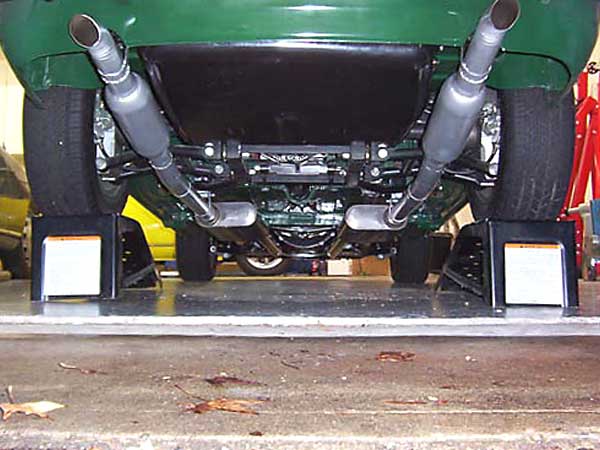
Rear Suspension
All of the suspension components are nicely made, mostly of powder coated tubular steel. The exception is the hub carriers which seem to be CNC machined out of billet aluminum which is then clear anodized. I took an approximate weight of the assembly, complete with brakes, and found that it was very close to the weight of the stock MGB axle and metal leaf springs. With fiberglass leaf springs, there could be less weight at the rear of the car, depending on what axle was chosen. Of course, most of the Hoyle weight is unsprung so that is an advantage.The unit installs easily. To get working room it is necessary to remove the fuel tank. Also, be sure that the upper rear mounting tab on the differential is cut off. It is not used, and if left in place it will hit the trunk floor. Begin installation by first attaching the main assembly using the existing shock mount holes in the frame. Shims are supplied to compensate for production variations in the frame rail spacing. The next step is to loosely attach the arms that extend from the front spring mounts to the suspension frame. I found that the arms were a long way from reaching my suspension frame so I had to buy longer bolts and use a generous amount of washers. When changing hardware be aware that all of the threaded fasteners on the suspension assembly itself are metric. Once these steps are completed, drill holes through the limit strap brackets on the frame into and through the tabs on the suspension assembly. Then install the bolts, being sure to use the aluminum spacers between the bracket ears.
It helps to "preload" the suspension bolts to prevent slight movements that make a creaking noise every time the car begins to move. To do this, first remove the bolts from the spring mount arms to the suspension frame, but do not loosen any of the bolts holding the suspension frame to the shock mount holes or to the rebound strap hole. Then jack up the car by the rear of the suspension frame. Even with the tight bolts this will cause the front of the frame to move slightly away from the spring mount arms as the frame settles. Gather enough washers to take up all of the space between the arms and frame, then insert and tighten the arm to frame bolts.
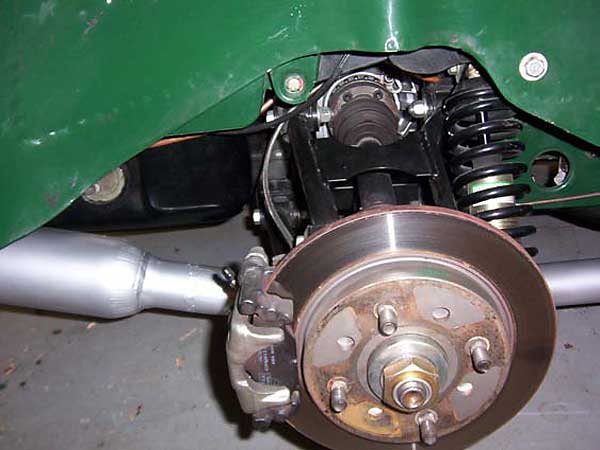
With the basic assembly in place, the drive shaft measurements can be made. Be sure to leave about 1/2 to 3/4 of an inch clearance between the transmission drive yoke and the rear of the transmission housing. Finding a rear yoke to mate to the pinion flange is very difficult. The Ford cars used factory balanced drive shafts that were not rebuildable. Even now, replacements are only available as complete assemblies. I found that Cannon Drive Shafts (10921 Chandler Boulevard, North Hollywood, California USA 91601. Phone: (818) 508-0123. E-mail: 1.drive@cannonengineering.com) had access to the proper yoke and could make up a shaft to my specifications. This they did in a few days at a very reasonable price. Be sure to specify a shaft diameter no larger than 1 3/4 inch, otherwise the shaft will not clear the parking brake mechanism. If you want a local shop to build your drive shaft, be sure to order a rear flange from John Hoyle along with the suspension kit.
Important! Earlier I put a rubber bumper shaft tunnel plate at the rear of my driveshaft tunnel. This turned out to be fortunate because if you leave the smaller chrome bumper plate on your early car, it appears it would be necessary to remove either the rear suspension assembly, or the engine and transmission, to install or remove the driveshaft from the tunnel.
Parking Brake: The suspension kit includes cables and fittings to connect up the parking brake to the existing MGB lever. My kit had no instructions, but the construction was obvious. A clamp is installed at the rear of the tunnel to hold the outer cable sheaths, and then an equalizing plate installs on the existing MGB brake lever rod and holds the inner cable ends. Adjustment is the same as with the stock system. However, the brake only works on the disk pads, not a separate internal drum as most cars now have, and so the brake holding action is feeble. Be sure to run the brake cables where they will not get damaged and fasten them as needed with tie wraps.
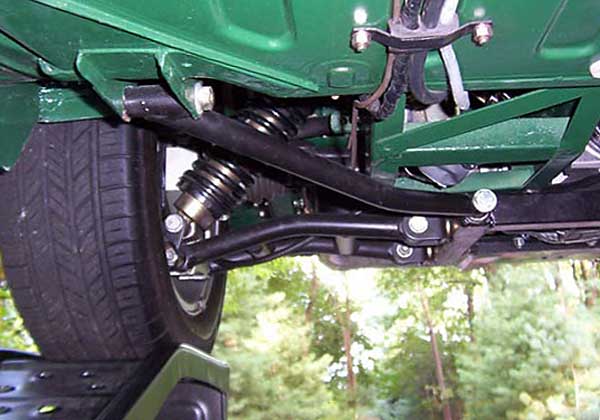
Road Brakes: Very long stainless brake hoses are supplied. These can be connected to the MGB brake pipe T, but the T must be relocated to a point near the front top of the suspension frame. I used flare-to-AN adapters to fit the hoses to the T. Be very careful to run the brake hoses where they will cause no damage. I tied them down where it seemed necessary using tie wraps over small pieces of rubber hose placed on the brake hoses as cushions.
Tightening suspension fasteners: A general rule is that nothing on the assembled suspension is fully tightened. Check all nuts and bolts, including the large nuts holding the hubs in place. As with any suspension, do not tighten the actual joint bolts until the suspension is compressed to its normal ride height. However, with the standard urethane bushings in all of the A-arm pivot points, this becomes less important.
Differential notes: The fill plug cannot be reached with the fuel tank in place. Keep this
in mind. The differential has a small vent hose rubber extension. I replaced it with a
longer hose that I ran through an existing hole into the trunk.
Fuel tank: The fuel tank cannot be installed with the suspension in place because its flange does not clear the suspension frame. What has to be done is to support the chassis of the car, remove the support arms from the suspension frame to the front spring mounts, and then the suspension frame bump strap bolts and rear (former lever arm) shock mount bolts. The suspension unit, which is then hanging on one bolt on each side, can be tilted forward far enough to get the tank in place. One installed, the tank body easily clears the suspension components.
Adjustments: The camber and toe in are adjustable by means of shim washers inserted between the A-arm pivot mounts and the suspension frame. Even the rear track is slightly adjustable by means of the shims. In addition, the spring height and shock damping are adjustable.
Spare wheel clearance: I am using 15 inch Panasport road wheels and these cleared all the suspension components with no problem. However, I am using an original Rostyle wheel as a spare, and this would not fit on the rear. What was needed was to grind down the lower shock mounts to clear. I called John Hoyle and he said that that would not cause any problems so I did it.
Aside from ride quality, the real question is, does this suspension system offer any performance advantage over an upgraded and well sorted out, modified MGB suspension with say, tube shocks, Panhard rod, radius rods and fiberglass springs? To be honest, in its present state of tune my suspension is probably no better. But it has much more potential due to its fundamentally better predictability (especially in the rear) and lower rear unsprung weight, as well as its huge adjustability.
Most of the adjustability advantages are at the rear due to replacing a simple axle with a double A-arm independent set up. For the first time rear camber and toe in are adjustable, as well as shock damping and ride height. In addition more subtle adjustments are possible. Especially interesting effects can come from mixing urethane and rubber bushings. For example, by only replacing the rear urethane A-arm pivot bushings with softer MGB V8 front bushings, oversteer can be decreased. On hard cornering, the greater load deflection of the softer bushings will cause the outer rear wheel to turn slightly out which will decrease oversteer. Putting the soft bushings at the front pivots will, of course, increase oversteer. The point is, with all of the adjustments possible, this suspension system is bound to produce better results than a more traditional system.
What don't I like about the Hoyle suspension? The choice of pads for the rear brakes is very limited. MinTex pads put out a huge amount of dust, and EBC Green Stuff pads, although they are supposed to be almost dust free, were even worse. John Hoyle is aware of the dust problem and says that the Green Stuff pads should cure it. Maybe I should try again. Another problem is that the A-arms require the exhaust pipe(s) to be even lower than a live axle set up (there is no way the pipes can be run over top of the suspension). A final drawback of the design is more difficult maintenance of the differential. The fuel tank must be removed to change the differential oil, and removing the tank requires nearly removing the suspension frame.
What do I like about the Hoyle suspension? Everything else! I also like the fact that John Hoyle is extremely helpful and supportive.
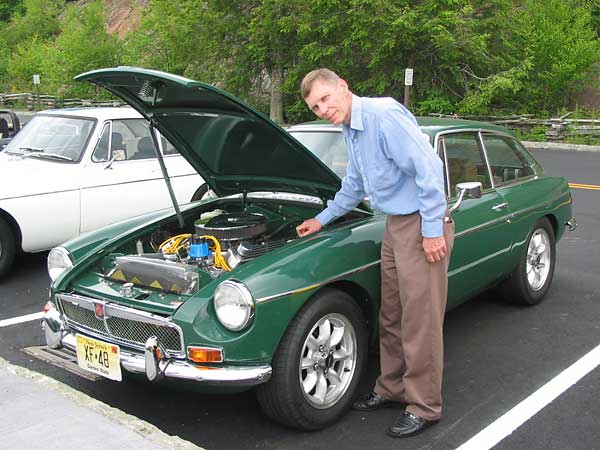
(Notice: comments about non-suspension aspects of Larry's MGB which appeared at the end of THIS article in the print-edition of the newsletter have now been REMOVED to the appropriate page of the "MG Photo Gallery": www.britishv8.org/MG/LarryShimp.htm.)
Editor's note: follow-up information including Larry's upgrades to the Hoyle IRS can be found in "Hoyle IRS Suspension Mods: New Anti-Sway Bar and Stronger Axles" which appears in British V8 Newsletter, Volume 14 Issue 3, December 2006.
Disclaimer: This page was researched and written by Larry Shimp. Views expressed are those of the author, and are provided without warrantee or guarantee. Apply at your own risk.
Photos by Curtis Jacobson. All rights reserved.
Fuel tank: The fuel tank cannot be installed with the suspension in place because its flange does not clear the suspension frame. What has to be done is to support the chassis of the car, remove the support arms from the suspension frame to the front spring mounts, and then the suspension frame bump strap bolts and rear (former lever arm) shock mount bolts. The suspension unit, which is then hanging on one bolt on each side, can be tilted forward far enough to get the tank in place. One installed, the tank body easily clears the suspension components.
Adjustments: The camber and toe in are adjustable by means of shim washers inserted between the A-arm pivot mounts and the suspension frame. Even the rear track is slightly adjustable by means of the shims. In addition, the spring height and shock damping are adjustable.
Spare wheel clearance: I am using 15 inch Panasport road wheels and these cleared all the suspension components with no problem. However, I am using an original Rostyle wheel as a spare, and this would not fit on the rear. What was needed was to grind down the lower shock mounts to clear. I called John Hoyle and he said that that would not cause any problems so I did it.
Aside from ride quality, the real question is, does this suspension system offer any performance advantage over an upgraded and well sorted out, modified MGB suspension with say, tube shocks, Panhard rod, radius rods and fiberglass springs? To be honest, in its present state of tune my suspension is probably no better. But it has much more potential due to its fundamentally better predictability (especially in the rear) and lower rear unsprung weight, as well as its huge adjustability.
Most of the adjustability advantages are at the rear due to replacing a simple axle with a double A-arm independent set up. For the first time rear camber and toe in are adjustable, as well as shock damping and ride height. In addition more subtle adjustments are possible. Especially interesting effects can come from mixing urethane and rubber bushings. For example, by only replacing the rear urethane A-arm pivot bushings with softer MGB V8 front bushings, oversteer can be decreased. On hard cornering, the greater load deflection of the softer bushings will cause the outer rear wheel to turn slightly out which will decrease oversteer. Putting the soft bushings at the front pivots will, of course, increase oversteer. The point is, with all of the adjustments possible, this suspension system is bound to produce better results than a more traditional system.
What don't I like about the Hoyle suspension? The choice of pads for the rear brakes is very limited. MinTex pads put out a huge amount of dust, and EBC Green Stuff pads, although they are supposed to be almost dust free, were even worse. John Hoyle is aware of the dust problem and says that the Green Stuff pads should cure it. Maybe I should try again. Another problem is that the A-arms require the exhaust pipe(s) to be even lower than a live axle set up (there is no way the pipes can be run over top of the suspension). A final drawback of the design is more difficult maintenance of the differential. The fuel tank must be removed to change the differential oil, and removing the tank requires nearly removing the suspension frame.
What do I like about the Hoyle suspension? Everything else! I also like the fact that John Hoyle is extremely helpful and supportive.

(Notice: comments about non-suspension aspects of Larry's MGB which appeared at the end of THIS article in the print-edition of the newsletter have now been REMOVED to the appropriate page of the "MG Photo Gallery": www.britishv8.org/MG/LarryShimp.htm.)
Editor's note: follow-up information including Larry's upgrades to the Hoyle IRS can be found in "Hoyle IRS Suspension Mods: New Anti-Sway Bar and Stronger Axles" which appears in British V8 Newsletter, Volume 14 Issue 3, December 2006.
Disclaimer: This page was researched and written by Larry Shimp. Views expressed are those of the author, and are provided without warrantee or guarantee. Apply at your own risk.
Photos by Curtis Jacobson. All rights reserved.

